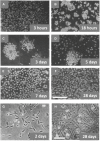Transit Amplifying Cells (TACs): a still not fully understood cell population
- PMID: 37229487
- PMCID: PMC10203484
- DOI: 10.3389/fbioe.2023.1189225
Transit Amplifying Cells (TACs): a still not fully understood cell population
Abstract
Maintenance of tissue homeostasis and tissue regeneration after an insult are essential functions of adult stem cells (SCs). In adult tissues, SCs proliferate at a very slow rate within "stem cell niches", but, during tissue development and regeneration, before giving rise to differentiated cells, they give rise to multipotent and highly proliferative cells, known as transit-amplifying cells (TACs). Although differences exist in diverse tissues, TACs are not only a transitory phase from SCs to post-mitotic cells, but they also actively control proliferation and number of their ancestor SCs and proliferation and differentiation of their progeny toward tissue specific functional cells. Autocrine signals and negative and positive feedback and feedforward paracrine signals play a major role in these controls. In the present review we will consider the generation and the role played by TACs during development and regeneration of lining epithelia characterized by a high turnover including epidermis and hair follicles, ocular epithelial surfaces, and intestinal mucosa. A comparison between these different tissues will be made. There are some genes and molecular pathways whose expression and activation are common to most TACs regardless their tissue of origin. These include, among others, Wnt, Notch, Hedgehog and BMP pathways. However, the response to these molecular signals can vary in TACs of different tissues. Secondly, we will consider cultured cells derived from tissues of mesodermal origin and widely adopted for cell therapy treatments. These include mesenchymal stem cells and dedifferentiated chondrocytes. The possible correlation between cell dedifferentiation and reversion to a transit amplifying cell stage will be discussed.
Keywords: cell dedifferentiation; cell reprogramming; cultured cells; hair follicle; intestinal crypt; stem cells; tissue differentiation; tissue regeneration.
Copyright © 2023 Cancedda and Mastrogiacomo.
Conflict of interest statement
The authors declare that the research was conducted in the absence of any commercial or financial relationships that could be construed as a potential conflict of interest.
Figures



Similar articles
-
Transit-amplifying cells orchestrate stem cell activity and tissue regeneration.Cell. 2014 May 8;157(4):935-49. doi: 10.1016/j.cell.2014.02.057. Cell. 2014. PMID: 24813615 Free PMC article.
-
Emerging roles of transit-amplifying cells in tissue regeneration and cancer.Wiley Interdiscip Rev Dev Biol. 2017 Sep;6(5):10.1002/wdev.282. doi: 10.1002/wdev.282. Epub 2017 Jul 3. Wiley Interdiscip Rev Dev Biol. 2017. PMID: 28670819 Free PMC article. Review.
-
Reciprocal interaction between mesenchymal stem cells and transit amplifying cells regulates tissue homeostasis.Elife. 2021 Jan 22;10:e59459. doi: 10.7554/eLife.59459. Elife. 2021. PMID: 33480845 Free PMC article.
-
Epithelial-Mesenchymal Micro-niches Govern Stem Cell Lineage Choices.Cell. 2017 Apr 20;169(3):483-496.e13. doi: 10.1016/j.cell.2017.03.038. Epub 2017 Apr 13. Cell. 2017. PMID: 28413068 Free PMC article.
-
Plasticity of Intestinal Epithelium: Stem Cell Niches and Regulatory Signals.Int J Mol Sci. 2020 Dec 31;22(1):357. doi: 10.3390/ijms22010357. Int J Mol Sci. 2020. PMID: 33396437 Free PMC article. Review.
Cited by
-
The Potential Reversible Transition between Stem Cells and Transient-Amplifying Cells: The Limbal Epithelial Stem Cell Perspective.Cells. 2024 Apr 25;13(9):748. doi: 10.3390/cells13090748. Cells. 2024. PMID: 38727284 Free PMC article. Review.
-
Crosstalk with infant-derived Th17 cells, as well as exposure to IL-22 promotes maturation of intestinal epithelial cells in an enteroid model.Front Immunol. 2025 May 1;16:1582688. doi: 10.3389/fimmu.2025.1582688. eCollection 2025. Front Immunol. 2025. PMID: 40375988 Free PMC article.
-
The Phoenix of stem cells: pluripotent cells in adult tissues and peripheral blood.Front Bioeng Biotechnol. 2024 Jul 30;12:1414156. doi: 10.3389/fbioe.2024.1414156. eCollection 2024. Front Bioeng Biotechnol. 2024. PMID: 39139297 Free PMC article. Review.
-
Protective Effect of Conditioned Medium of Immortalized Human Stem Cells from Exfoliated Deciduous Teeth Against Hair Graying Caused by X-Ray Irradiation via Its Antioxidative Activity.Antioxidants (Basel). 2025 Jan 18;14(1):109. doi: 10.3390/antiox14010109. Antioxidants (Basel). 2025. PMID: 39857443 Free PMC article.
-
Immune modulatory stem cells represent a significant component of the immune system.Front Immunol. 2025 Mar 3;16:1543495. doi: 10.3389/fimmu.2025.1543495. eCollection 2025. Front Immunol. 2025. PMID: 40098974 Free PMC article. No abstract available.
References
Publication types
LinkOut - more resources
Full Text Sources

